Students not only learn new skills but also may improve in learning and test scores.
| 2016 Q3 | story by EMILY MULLIGAN
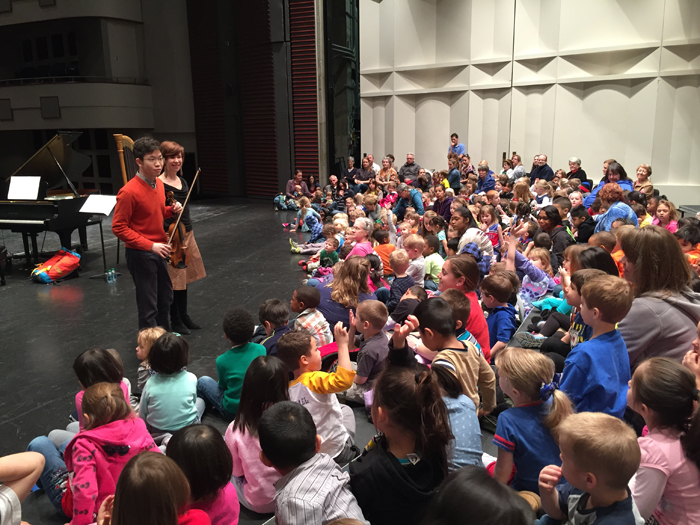
Concert violinist Paul Huang and pianist Jessica Xylina Osborne leading a Performing Arts 3to5 workshop for area pre-school students. Courtesy of the Lied Center of Kansas
Art is not just pretty or entertaining, and it is certainly not frivolous. For so many people and entities in Douglas County, art is a business. And for local students of all ages, it turns out that experiencing art can help them be better people and lead more fulfilling, successful lives.
The Lawrence Arts Center annually offers more than 450 classes and workshops to about 9,000 students in preschool through 12th grade. Students can choose from among dance classes, including tap, ballet, jazz and hip-hop; theater and filmmaking classes; and art classes, such as drawing, painting, pottery and photography. Students will learn a variety of skills from those classes, and Chief Program Officer Margaret Weisbrod Morris says that hands-on abilities are not the only thing students will gain.
“This is a place about teaching and practicing creativity, however, you’re going to integrate it into your life. We are very conscious about it, and we want to teach you how to apply your knowledge,” she says.
Ultimately, the instruction the Arts Center provides is not just about learning and perfecting the art itself, although the Arts Center has strict curricula to make sure students do learn the art techniques. Many large, longitudinal research studies show a strong correlation between arts experiences for students and their achievements in school and beyond, according to the National Endowment for the Arts.
Young children who regularly participate in arts activities such as music lessons showed significant improvements in non-verbal IQ, numeracy and spatial cognition versus children who did not have those same arts activities, one study found. Elementary school children with higher levels of arts participation had higher test scores in science and writing, according to another study.
Studies have shown that high school students of all socioeconomic levels who engage in the arts enroll in four-year colleges at higher rates and are three times more likely to earn a bachelor’s degree. Arts participation also tracks as a precursor to higher-paying, professionally rewarding jobs.
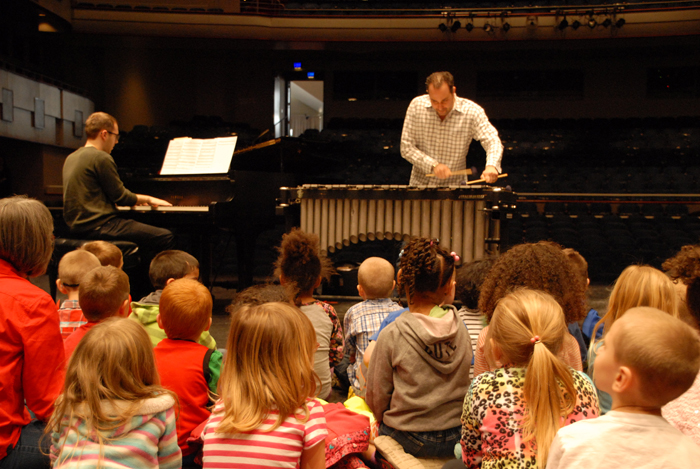
Vibraphonist Christian Tamburr and pianist Addison Frei leading a Performing Arts 3to5 workshop for area pre-school students
Lied Center Education Outreach
Attending arts events and live arts performances can be as influential as taking lessons or classes. The Lied Center of Kansas has had a partnership with Lawrence Public Schools since the Lied Center opened 23 years ago, providing opportunities for local elementary school children to see live arts performances. Recently, that program has been expanded through private donations to include middle school and high school students.
“Every kid in the school district is brought to one performance every year—that is 10,000 students every year,” says Anthea Scouffas, Lied Center engagement/education director.
Scouffas says that although many of Lawrence’s students are familiar with the arts, many others are not, and it is evident when they first arrive at the Lied Center.
“We hear the kids ask, ‘What movie are we seeing?’ because when they hear the word ‘theater,’ the movie theater is all they know about. For many of them, this is their only exposure,” she says.
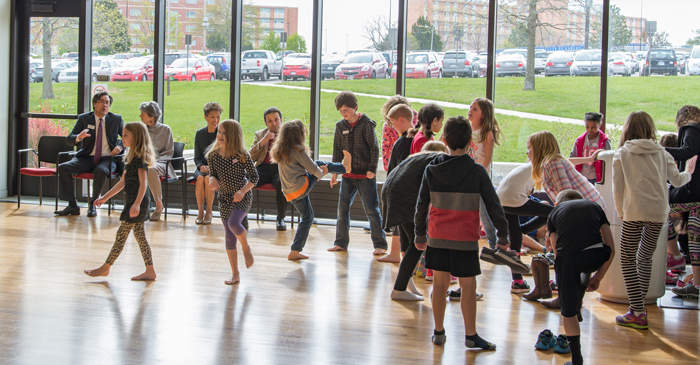
National Endowment for the Arts (NEA) Chairman Jane Chu, NEA State & Regional Director Laura Scanlan, Kansas Creative Arts Industries Commission Director Peter Jasso and Lied Center Executive Director Derek Kwan observing a movement workshop during Third Grade Theater Arts Day. Courtesy of the Lied Center of Kansas
Executive Director Derek Kwan explains that the Lied Center is the only performing arts center he knows with performances for which the students and the school district do not have to pay.
“That makes the experience barrier-free for the students. Everyone should have access to the arts—this literally provides for every single student,” Kwan says.
Kwan helped raise the private funds to expand the schools program for five years, and he says the Lied Center is more than halfway toward establishing a permanent endowment for the program.
“When I arrived here, I realized we needed to invest more in education. Kindergarten through 5th-grade programs had been covered for many years, but some of the most formative years are middle school and high school. You never know when that spark will hit,” he says.
For the older students, the Lied Center tries to bring not only high-quality performances in a variety of genres but also performances related to issues that those students face. Scouffas attends an international conference every year from which to cull the performances, and she coordinates with school counselors and teachers to make sure the topics are relevant to local students.
For example, last year’s middle school program was about cyberbullying. This year’s high school program, called “Still/Falling,” is a one-woman play about a high school student with anxiety and depression.
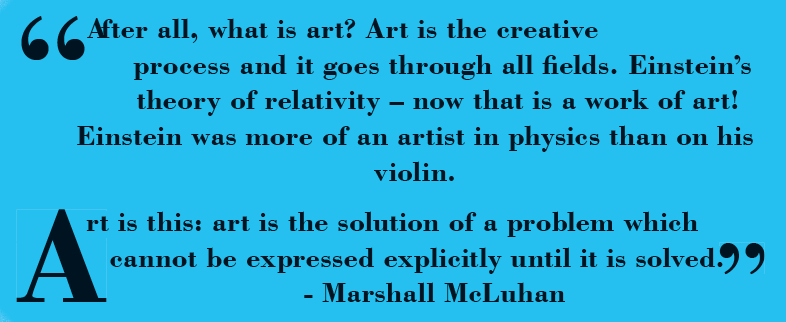
For all of the school performances, the Lied Center creates a handout for students with related activities for the younger students and additional resources for the older students.
One year’s Lied Center school performance had a measurable and remarkable impact on local students. In 2011, a duo called Black Violin performed for elementary students at the Lied Center. The duo specializes in playing a wide range of music genres on violins. Scouffas says after that performance, the number of students in the school district requesting to play violin increased so much, the district had a shortage of the instruments. This past year, Black Violin returned, and many of those students who still play violin were able to thank the duo for their influence.
Scouffas and Kwan also have given students a window into the workings of the Lied Center itself, trying to educate students that not all careers in the arts involve being in the spotlight, so to speak.
“Most performing arts centers are filled with people who knew they were into the arts but wouldn’t make it on their art ability alone. So they found a way to make a career,” Scouffas says.
Kwan explains that part of the Lied Center’s role in the University is to work with high school and college students to educate them about how to succeed outside of the art form, such as in audience engagement and marketing.
The Lied Center staff has mentored both individuals and ensembles, particularly in music, to teach them about those things and more.
“We show them that there are so many careers in the arts that are beyond the stage, such as being a business manager, record promoter, box office manager or front-of-house manager,” Kwan says.
Eight years ago, the Lied Center was instrumental in creating “Third Grade Theater Arts Day,” a full-day field trip for all Lawrence third graders that provides arts activities and information about arts genres and careers. Now the event has grown, and the Lied Center conducts the two-day event in conjunction with the Lawrence Arts Center and Theatre Lawrence.
Local artists and instructors present mini workshops to the children at all three sites. Activities have included puppetry, dance, acting, stage lighting and even makeup.
“We want them to learn about theater arts, but we also want them to say that they had fun all day,” Scouffas says.
Scouffas and Kwan say that Lawrence public schools offer excellent music programs and theater programs in middle school and high school, so there are opportunities for students to experience those during the school day. If there is one thing missing from the public schools’ curriculum, it is dance instruction, they agree.
“We live in an incredible community with incredible schools. Kids should have access to whatever positive forces can help get them through school,” Scouffas says.
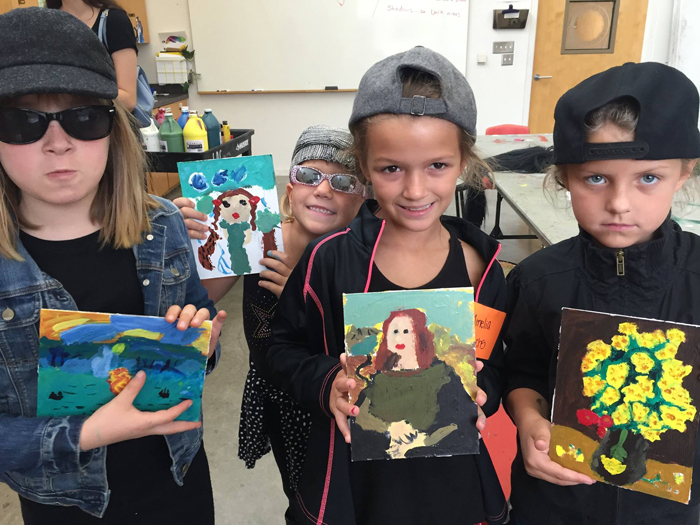
Youth artists enjoy an I, Spy summer camp as part of the Arts Center’s youth education program. Courtesy of Lawrence Arts Center
Arts Center Arts Instruction
What the Lawrence school district leaves off with arts education, the Lawrence Arts Center more than makes up for. Its annual catalogs are filled to the brim with after-school, weekend and even day-off-school programs in all types of arts.
Although the Arts Center’s programs are provided at additional cost to families, it also offers a scholarship program to help make the arts accessible to all local students. The Lawrence Arts Center Financial Aid Fund provides scholarships for more than 800 people each year because of funding from private donors and the city. In addition to children’s scholarships, the Arts Center also has a scholarship fund with Douglas County Senior Services for students 55 and older.
Morris says the Arts Center writes its own curriculum for all of the genres and categories of art taught. The curriculum is based on design thinking and has benchmarks and teaching techniques that incorporate the national standards of each field. For example, ballet curriculum draws from centuries-old levels of training. Classes like painting and drawing follow the backbone of what arts schools have been teaching for centuries, as well: concepts such as color theory, shading and hand-eye coordination.
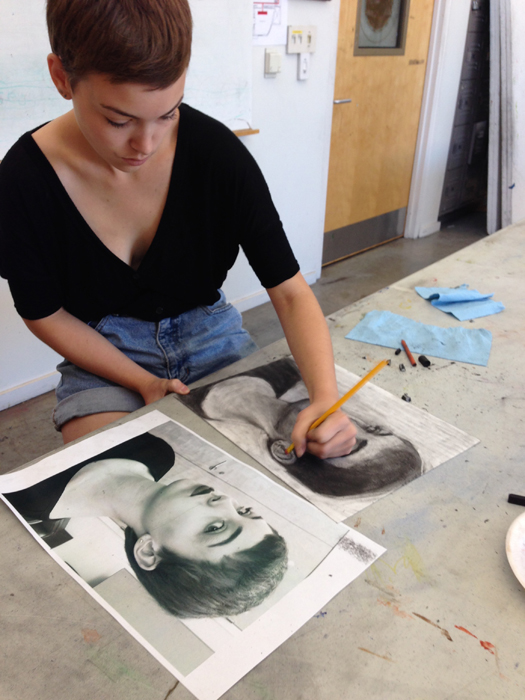
Young artist further’s her drawing skills in an Arts Center Arts Institute class. Courtesy of Lawrence Arts Center
The Arts Center’s curriculum committee comprises masters-level licensed teachers and meets weekly,” Morris explains. “As the curriculum is established, the committee works to connect it with what the students are learning in school at each grade level and with books and popular culture that resonate with students.
“We have to decide: What is the most fun and engaging way to do it? We know no matter what, it has to feel like fun, or they’re not going to engage in it. We have to make sure that people love being here,” she continues.
The Arts Center has many presentations of its students’ work, from bulletin boards and display cases of visual art to the School of Dance’s annual Showcase to the large-scale Summer Youth Theater productions. The artists and performers enjoy displaying their final products, but Morris says the learning and creating processes are actually the most important part.
“You have to think critically and push yourself past what you think is possible in the moment,” she explains. “Failure is part of learning. You can’t give up; you can’t be afraid. Whatever you make is better through the failures. You have to learn to be confident and seek out that experience.”
Kwan and Scouffas, of the Lied Center, connect the art education mind-set to what the research studies show. They say businesses—both inside and outside of the art world—are looking for people who have “soft skills” like critical thinking and creativity.
“The key thing is that out of all these trainings, even if you don’t pursue it as a profession, it lays a foundation for you becoming an artist citizen of the world,” Kwan says. “If you look at what makes great moments in history, it has been either art or wars.”

3 Comments
new apartment gifts rentberry scam ico 30m$ raised honolulu apartments
hi!,I really like your writing very a lot! proportion we
be in contact extra about your article on AOL? I require an expert on this
space to solve my problem. Maybe that is you!
Having a look forward to peer you.
you want to come and see click for more to connect because my eyes are seductive